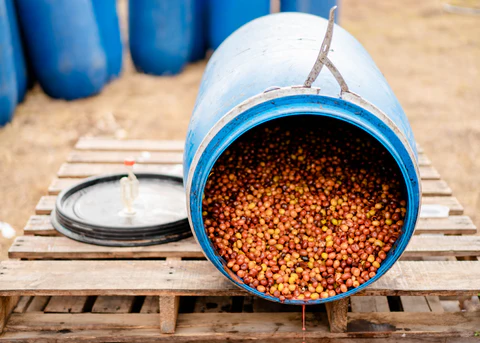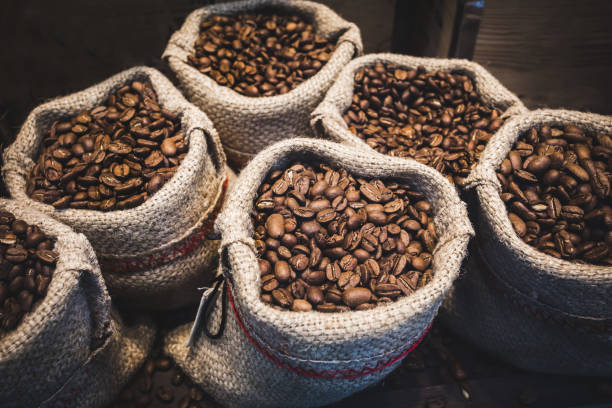Grind consistency is one of the unsung heroes in the quest for the perfect cup of coffee or espresso. Whether you’re a home barista or a café owner, understanding and mastering grind consistency can elevate your coffee game significantly.
In this article on How to Test and Improve Grind Consistency, we’ll dive into why grind consistency is crucial, how it impacts the flavor and extraction of your brew, and provide you with practical methods to test and improve your grind consistency.

Understanding Grind Consistency
Before we dive into the nitty-gritty, let’s break down what grind consistency really means and why it’s so important.
Definition and Significance: Grind consistency refers to the uniformity of coffee grounds after they’ve been through your grinder. When all the particles are roughly the same size, they extract at a similar rate, leading to a balanced flavor profile. Uneven particles, however, extract at different rates – smaller ones over-extracting and larger ones under-extracting – causing a muddled flavor.

Factors Affecting Grind Consistency: Several factors can mess with your grind consistency:
- Grinder Type: Blade grinders tend to produce uneven particles, while burr grinders are known for their consistency.
- Grinder Quality: Even among burr grinders, the quality of the burrs and the grinder’s construction can make a big difference.
- Maintenance: A dirty grinder can lead to clumping and uneven grinds. Regular cleaning is key.
- Bean Quality: Freshness and roast level can also impact how evenly beans grind.

Testing Grind Consistency
Okay, now that we know what grind consistency is and why it’s important, let’s talk about how to test it. Here are some simple methods to check if your grind size is up to par:

1. The Sieve Test:
- Use a set of coffee sieves (like the Kruve Sifter) to separate your grinds into different sizes.
- Shake a sample of ground coffee through the sieves and see how much falls into each category.
- A consistent grind will have most particles in one or two sizes.
2. Visual Inspection:
- Spread your ground coffee on a white piece of paper.
- Examine the particles closely. A good grind should look uniform, without too many fine (powder-like) or coarse (chunky) pieces.
3. Brew Method Testing:
- Brew a batch of coffee and taste it.
- If it’s consistently over-extracted (bitter) or under-extracted (sour), your grind may be uneven.
Improving Grind Consistency
Now, let’s get into the heart of the matter: improving your grind consistency. Here are some actionable tips:
1. Choosing the Right Grinder:
- Invest in a high-quality burr grinder. Brands like Baratza, Eureka, and Mazzer are known for their consistency.
- Avoid blade grinders, as they produce uneven particles.
2. Grinder Maintenance and Calibration:
- Clean your grinder regularly to prevent old coffee particles from affecting new grinds.
- Calibrate your grinder according to the manufacturer’s instructions to ensure the burrs are aligned properly.
3. Best Practices for Consistent Grinding:
- Use fresh coffee beans. Stale beans can lead to inconsistent grinds.
- Adjust your grind size based on the brew method. For example, espresso requires a fine grind, while French press needs a coarse grind.
- Grind just before brewing to preserve the freshness and consistency of the grounds.
Current Trends and Statistics
To give you a sense of how important grind consistency is in today’s coffee culture, here are some current trends and statistics:

- Specialty Coffee Growth: The specialty coffee market is booming, with consumers willing to pay more for high-quality, consistently ground coffee.
- Consumer Preferences: A recent survey found that 70% of coffee drinkers believe grind consistency directly impacts the taste of their coffee.
- Technological Advances: Modern grinders with digital settings and precise controls are becoming more popular, making it easier for coffee enthusiasts to achieve a consistent grind.
Mastering grind consistency might seem like a small detail, but it can make a huge difference in the quality of your coffee. By understanding what affects grind consistency, testing your grounds, and following best practices, you can ensure that every cup you brew is balanced and delicious. So, grab your grinder, experiment with these tips, and get ready to enjoy some seriously good coffee!
Methods for Testing Grind Size
Testing your grind size is the first step in mastering your brew. Here, we’ll walk you through some tried-and-true methods: visual inspection, sieving, and measuring grind size distribution. Let’s dive in!
Visual Inspection
Visual inspection is the easiest and quickest method to get a sense of your grind consistency. Here’s how to do it:

- Prepare Your Workspace: Spread a white piece of paper or a light-colored plate on a flat surface. This helps you see the particles clearly.
- Grind Your Coffee: Use your grinder to prepare a sample. Make sure to grind the coffee as you would normally for your brew method (espresso, pour-over, etc.).
- Spread the Grounds: Gently spread the coffee grounds on the paper or plate. Try to create a thin, even layer.
- Examine the Particles: Look closely at the grounds. A consistent grind will have particles that are uniform in size. You shouldn’t see a lot of fine powder (which can cause over-extraction) or large chunks (which can cause under-extraction).
Interpreting Results:
- Uniform Particles: Your grind is consistent, and you’re on the right track.
- Mixed Particles: If you see a mix of fine and coarse particles, it’s time to adjust your grinder or check for maintenance issues.
Sieving Method
For a more precise assessment, you can use the sieving method. This method separates your coffee grounds into different size categories, allowing you to see the distribution more clearly.

- Get a Coffee Sieve: Invest in a coffee sieve set, such as the Kruve Sifter. These sets come with multiple screens of varying sizes.
- Prepare Your Sample: Grind a batch of coffee as you normally would.
- Sift the Coffee: Place the ground coffee in the top sieve and shake gently for a few minutes. The sieves will separate the grounds into different size fractions.
- Analyze the Results: Examine the different compartments of the sieve. Each compartment will contain particles of a specific size range.
Interpreting Results:
- Balanced Distribution: If most of your coffee grounds fall within one or two sieves, your grind is consistent.
- Wide Distribution: If the grounds are spread across many sieves, you need to adjust your grinder settings.
Measuring Grind Size Distribution
For the tech-savvy coffee lover, measuring grind size distribution provides the most detailed analysis. This method often requires specialized equipment, but it’s the gold standard for precision.

- Prepare Your Equipment: You’ll need a particle size analyzer or a high-resolution digital microscope.
- Grind Your Coffee: Use your grinder to prepare a sample.
- Analyze the Grounds: Follow the equipment instructions to measure the size of the coffee particles.
- Review the Data: The analyzer will provide a detailed breakdown of the particle sizes in your sample.
Interpreting Results:
- Narrow Distribution Curve: A consistent grind will show a narrow, bell-shaped curve on the distribution graph.
- Wide Distribution Curve: A wide curve indicates variability in particle size, suggesting the need for grinder adjustments.
Testing your grind size is essential for achieving consistent and delicious coffee. Whether you opt for a quick visual inspection, the more precise sieving method, or the detailed measurement of grind size distribution, each technique offers valuable insights into your grind consistency. By regularly testing and tweaking your grinder settings, you can ensure that every cup of coffee you brew is as perfect as possible.
Tips for Improving Your Grind
Now that you know how to test your grind size, it’s time to improve it. Achieving consistent grind size can be a game-changer for your coffee’s flavor and aroma. Here are some practical tips to help you get there:

Regular Maintenance and Cleaning
- Keep It Clean:
- Regular Cleaning: Clean your grinder at least once a week. Old coffee particles and oils can build up, leading to inconsistent grinds and off-flavors.
- Deep Cleaning: Once a month, take apart your grinder for a thorough clean. Use a brush and mild detergent to clean the burrs and other parts. Avoid using water on the burrs unless specified by the manufacturer.
- Check for Wear and Tear:
- Burr Replacement: Over time, the burrs in your grinder can wear down. Check the manufacturer’s recommendations for replacement frequency and keep an eye on the performance. Dull burrs can lead to inconsistent grinds.
Proper Grinder Adjustments
- Adjusting Grind Size:
- Start with the Basics: Refer to the grind settings recommended by your grinder’s manual for your desired brew method.
- Fine-Tuning: Make small adjustments to the grind size and test the results. Move the setting a notch finer or coarser, brew a cup, and taste the difference.
- Calibrating Your Grinder:
- Factory Settings: Some grinders come with factory calibration. Ensure your grinder is properly calibrated according to the instructions.
- Manual Calibration: If your grinder allows for manual calibration, follow the steps to align the burrs correctly. This can significantly improve grind consistency.
Experimenting with Grind Sizes
- Try Different Sizes:
- For Espresso: Start with a fine grind. Espresso requires a fine grind to ensure a strong, concentrated shot.
- For Pour-Over: A medium grind works best. It allows for an even extraction without clogging the filter.
- For French Press: Go coarse. The larger particles prevent over-extraction and sediment in your cup.
- Record Your Results:
- Keep a Journal: Note down the grind size settings, brew method, and taste results. This helps you track what works best for each type of coffee and brew method.
- Adjust and Test: Based on your notes, make slight adjustments to the grind size and observe the changes in flavor and extraction.
Investing in Quality Equipment
- Choose the Right Grinder:
- Burr vs. Blade: Always go for a burr grinder. Blade grinders are inconsistent and can’t produce the same level of precision.
- Grinder Quality: Invest in a high-quality grinder from reputable brands like Baratza, Breville, or Eureka. While they may be more expensive, they offer superior grind consistency and durability.
- Upgrading When Needed:
- Assess Your Needs: If you’re not getting the consistency you want, it might be time to upgrade your grinder. Higher-end models offer better precision and more grind size options.
Consistent Practices
- Weigh Your Coffee:
- Use a Scale: Weighing your coffee before grinding ensures you use the right amount every time, leading to more consistent results.
- Grind Fresh:
- Just Before Brewing: Grind your coffee just before you brew. Pre-ground coffee loses freshness and can lead to uneven extraction.
Improving your grind consistency requires regular maintenance, proper adjustments, and a willingness to experiment. By keeping your grinder clean, making precise adjustments, and investing in quality equipment, you can ensure that your coffee grounds are consistently perfect. Keep track of your experiments and adjustments to continuously optimize your grind and enjoy the best possible coffee experience.
Disclosure: Our blog contains affiliate links to products. We may receive a commission for purchases made through these links. However, this does not impact our reviews and comparisons. We try our best to keep things fair and balanced, in order to help you make the best choice for you.






One Response